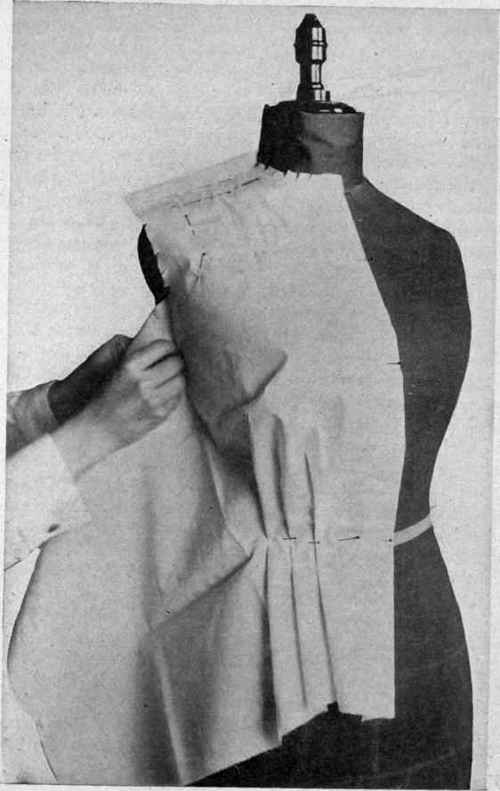Miscellaneous Designs. Part 5
Description
This section is from the book "Clothing For Women: Selection, Design, Construction", by Laura I. Baldt. Also available from Amazon: Clothing For Women: Selection, Design, Construction.
Miscellaneous Designs. Part 5
Draping Waists
A simple waist to be used for a corset cover or shirtwaist may be draped as follows: Lay box plait for front opening. Mark the center of the box plait, place tape about waist line of form. Place the center of box plait along center front of form; pin to place, leaving enough material at the neck to allow for shoulder seams after the neck is cut out. Smooth material across front so that the grain of the material lies straight across the chest; pin to place; smooth at the neck, cutting out enough to make it smooth, and being careful to leave plenty at the top of shoulder. Pin along the shoulder line, the position of which will vary with different figures. If shoulders are square or the back full, there is a tendency to appear round-shouldered. In this case, place the shoulder' seams back of the top of the shoulder. For sloping shoulders place the seam directly on top. Adjust the fulness at the waist line, laying it in backward, turning plaits or pinning the gathers. Mark the arm-hole line with pins. This line carries straight from the shoulder to the muscle in the front of the arm where its joins the body. Care must be taken not to make this line curve. Cut away all the extra material, allowing good seams.
Bach
Mark the lengthwise center of material with colored thread. Place this line to the center back, and pin to place, allowing for the shoulder and neck seam. Smooth the material across back so that the crosswise threads are straight across the back. Pin the shoulder seams together. Mark the armhole line. Arrange the fulness at the waist; a little fulness keeps the seams straight on under arm, much fulness makes the seam bias. Pin under arm seam and waist at belt. Allow two inches below the belt. Mark with pins the line on which it is desired to finish neck. Remove from form and baste for fitting; mark neck and armhole lines with colored thread (Fig. 80).
Waist With Fulness Coming From Underneath The Yoke
First, design the yoke without seam on shoulder, following any line at the lower edge which is suitable to the wearer. Mark with pins the line of the lower part of the yoke and turn the edges back, while at work on the lower part. Then drape the remainder of the waist, allowing fulness where it is to be gathered, tucked or plaited. Pin in tucks for a short distance, or gather where desired; draw up the threads, and replace the yoke and pin to place. Pin seams and mark arm-hole and neck lines. Remove from the form and baste for fitting.
Problem I
Drape a simple waist that can be used for a corset cover. Design a peplum for it, using a six-gored skirt pattern.
Problem II
Drape a waist suitable for lingerie material, placing tucks and designing a yoke without seam on shoulder.
Problem III
Drape an original problem, a waist suitable for silk to be worn without a coat suit.

Fig. 80. - Draping a simple waist.
Continue to:


